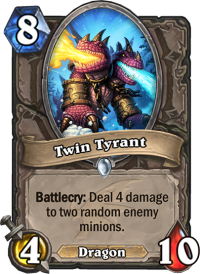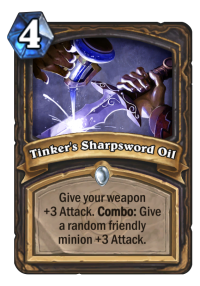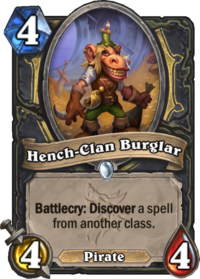The new Twist season for February 2024 is now underway, and players are hitting each other with some common cards, as the format does not allow any higher-rarity cards to be used. Not all commons are included either because the original Legacy set is missing as are all the most recent expansions. The available card pool includes the Core set, Caverns of Time, and the expansions from Curse of Naxxramas (2014) to Galakrond’s Awakening (2019-2020).
But what is it like to play with common cards only? It is not quite what I expected. When you play budget decks on the regular ladder, you almost always go for aggro because you cannot match the late-game value of regular decks. However, that late-game value does not exist in this Twist. Rare cards and many of the most powerful common cards are also missing, so the level of lethality is quite low. The mainstream strategies are midrange strategies that focus on value generation, especially with Dragons and Lackeys. Some aggressive strategies are also viable. There are no combo decks. Control decks cannot compete with all the midrange decks in the format.
On the first day, it looked like Dragon Warrior dominates the entire format, and it is a strong deck, but multiple challengers to its rule have already surfaced, and there are several ways you can succeed on the ladder.
Dragon Warrior – The Early Tyrant
Dragon Warrior is one of the strongest decks in Twist. It is played in many variants with small differences between them, and the sample sizes are too small to conclusively say which is the best variant. This deck currently has the highest win rate, but with a sample of just a hundred games, it is not clearly ahead of the competition:
- 1Execute2

- 1N’Zoth’s First Mate1

- 1Sky Raider2

- 1Slam2

- 2Bash2

- 2Dragon Roar2

- 2Frightened Flunky1

- 3EVIL Quartermaster2

- 3Ravaging Ghoul1

- 4Blood Razor1

- 4Sword Eater2

What makes Dragon Warrior so good?
- It has access to cheap hard removal in Execute, and there are not many hard-removal options available in the format.
- It has access to card draw through Slam, Acolyte of Pain, and Big Ol' Whelp. In a format where minions commonly trade, Slam is a great card that enables you to do more favorable trades while also thinning your deck. Warrior can also deal area-of-effect damage and make good use of Acolyte of Pain easier than many other classes.
- It has access to lots of resource generation thanks to Sky Raider, Dragon Roar, Netherspite Historian (not included in the featured deck), Frightened Flunky, and EVIL Quartermaster. In a format where drawing is difficult, the ability to generate resources while maintaining tempo can allow deck to outvalue its opponents.

Caverns of Time is extremely relevant for Dragon decks thanks to Future Emissary, which makes Dragons trade even more favorably. Another Dragon of note is the Twin Tyrant. I had expected it to be too slow for the format, but lethality is low enough that Twin Tyrant can get some incredibly favorable hits. Old-school Arena players saw this one coming; the Tyrant is back in another format!
The meta has started to adapt, though. People are teching in cards like Dragonslayer, also into Dragon Warrior decks. People are also using sturdier minions so that they cannot be removed with Warpath and Twin Tyrant. The featured list is already on this path of evolution. Dragonslayer is in and Warpath is out, as it was mostly useful against early aggro decks. Obviously, as the meta evolves, these tech slots will shift around and be filled with relevant cards. Rustrot Viper is a candidate for a tech slot, and you can even argue that the small whirlwind effects from Ravaging Ghoul and Blood Razor are tech choices.
Dragon Paladin – The New Tyrant?
One of the main answers to Dragon Warrior is Dragon Paladin.
Paladin cannot generate resources like a Warrior can, but it can make the most out of the cards it has. Grimestreet Outfitter gives Paladin more handbuffs, thus enabling more favorable trades. Paladin can also give its minions Divine Shield with Sand Breath and Potion of Heroism (not included in the featured list) to further improve trades. Amber Watcher can heal minions, so after making a good trade, your minion is ready for another. Add in Keeper of Uldaman, and the biggest Dragon may find itself turned into a small whelp.
This featured list also includes one of the top answers to Twin Tyrant: Bonemare. Drop a Bonemare on the turn right before Twin Tyrant is about to come out, and watch as its four damage strikes fail to actually destroy anything. The use of Bonemare is not exclusive to Dragon Paladin, and it is becoming one of the most important counters to Dragon Warrior.
Tempo Warrior Strikes Back
Warrior’s ability to generate additional resources can also be used in a non-Dragon shell. MagmaRager built this Tempo Warrior deck as an answer to the Dragon Warrior onslaught:
Note how the deck can generate tons of resources while maintaining pressure. It also has Dragonslayers ready to hunt some Dragons and Bonemares to make playing Twin Tyrant impossible. When I tried the deck on ladder, I actually had problems getting rid of all the cards that I drew and generated!
Aggro Cannot Die – Weapons and Tokens
While the format is not kind to aggro decks after all, there are still opportunities to get aggressive as well. You just need to be fast enough to get there before Bonemare and Twin Tyrant show up, and that limits your options as most classes do not have the card pool to find that lethality. The two main exceptions are Rogue and Druid.
Hanniballz built this Weapon Pirate Rogue that can go under the popular archetypes and win games quick.

I love the inclusion of Tinker's Sharpsword Oil. I have to admit, I was an Oil Rogue player instead of a Miracle Rogue enjoyer back in the day, and beating a Dragon Warrior on the ladder with Oil has been one of my best moments in Twist this season. The buffed EVIL Miscreant is a huge body that early, even more so when it can be buffed. Too bad Cold Blood is not legal in this format.
Another upside of Rogue is that it has some sweet resource generation too. In addition to EVIL Miscreant, the deck includes Swashburglar and Hench-Clan Burglar, both of which have saved the day for me.
An alternative approach to aggression is Token Druid. The most popular list is Corbett’s Undertaker Token Druid:
Make lots of minions, buff them, make them sturdier with Soul of the Forest, and profit!
I have been playing with the same idea myself, but I chose to play with Eggs instead. Eggs are fun!
Rogue Has More Tricks Up Its Sleeve
Rogue was expected to be one of the strongest classes thanks to a combination of Jades and Lackeys: Rogue has the strongest Common Jade card set with Jade Swarmer, Jade Shuriken, and Jade Spirit. So far, the winner of this style is Corbett’s Jade Rogue:
Jades and Lackeys are a given, and the final piece to the puzzle that Corbett found is Street Trickster that enables the deck to deliver impressive damage from hand with Razorpetals and Eviscerate. As Dragon decks start to stabilize with their big bodies, you can just shoot them in the face.
I wonder if taking this idea to the Weapon Rogue deck would also be a fruitful approach. With the limited draw in the format, it might not work as well there though. However, there is still room to explore the format, for example in that direction.
Back to the Days of Zoo Warlock
Zoolock used to be a deck that you could play in every expansion of Hearthstone. It is only more recently that synergistic card packages made the Warlock Hero Power combined with cheap minions an obsolete strategy. However, in this Twist format you can still play Zoo Warlock. A clear best list has not emerged yet, which is not a big surprise considering how many options you have when building the deck. I have mostly played my own version with a heavy focus on Lackeys, and it has taken down some Dragon Warriors too so I’ve been reasonably happy with it.
Lackeys are so incredibly useful in the format that I always want to include them whenever possible. The one doubt I have had about the deck is whether I should make room for a Bonemare somewhere. There are some Zoo lists with Bonemare that have not been successful, but they also omit Lackeys, so perhaps Bonemare could still contribute to the archetype when Lackeys are included.
Bubbling Under
There is still a fair bit of Twist left to explore. After all, it is a format where Mechwarper and Undertaker are legal!
I have been expecting a Mech Paladin to show up, but it has been surprisingly difficult to put together without Radar Detector. Drawing enough Mechs has felt a challenge. If you have a good list, let me know in the comments!
As for Undertaker, I have played this Undertaker Hunter list, but it feels a bit too reliant on its namesake. Sure, when you get the dream draw, you can beat anything.
I have also tried Shaman because a class with Tunnel Trogg, Totem Golem, and Flamewreathed Faceless has to have a playable deck in it somewhere. Indeed, when you draw those three cards, you can smack down some Dragon decks, but consistency is even worse than with Undertaker. Shaman does have some interesting value cards too, so maybe there is another way to build a Shaman deck.
I saw this slow Shaman build on Twitter and took it out for a spin, and it felt OK. Maybe there is still some more work to be done with the archetype, but this could be viable.
I have also seen some Secret Mages around, but they have failed to impress at all. None of the good Mage Secrets are Commons, so those decks have to give up a lot of power because of the card pool.
But What Does It Cost?

The big problem with Twist has been the cost to enter a format that is only around for a month. Now, this format consists of only common cards, so surely the barrier to entry is much lower? Well, only sort of. While all the cards are commons, the only Standard-legal cards that can be played in the format are Core set cards, and you cannot build a competitive deck for the format from the Core set. If you have no Wild cards, you are looking at crafting a deck for 1200 dust (30 Commons) – and even that is a lot of dust to spend for a single month. Commons are easy to get in packs, but there are so many sets in the format that you cannot effectively get cards for a deck by opening packs. If you did not play Hearthstone when the Twist expansions were legal and save your Common cards, it is still an investment to get into the format.
I tried to find a playable free deck for the format, but to no avail. This is the best I could build, and it cannot beat Dragon Warrior. It can beat many of the other decks on the ladder, but those Dragons are a bit too much value to overcome.
This is ironic, as free decks I built for earlier Twist formats were more competitive. Core set has some good cards in it, but when you can only use the Common cards from it, your options are very limited. Rogue has the best Core set commons, and you could upgrade from this to the Weapon Rogue list a bit cheaper than building most Twist decks. That’s the best I have to get you started in the format.
Conclusions
First, it looked like Dragon Warrior dominates this Twist format and generating random resources is the way to win games. After more play, it seems to me that generating random resources and outvaluing your opponent is a way to win games, but it is not the only one. It is not simple to build functional aggro decks for the format as the lethality is low, but there are still ways around that and you can succeed with the cards in your own deck too. For slower strategies, resource generation is important, although Paladin and to an extent Shaman seem to also be able to keep their minions around and extract more value from them.
If you have played Hearthstone for years and still have your Wild commons, it is easy to get into this Twist season and experiment with all possible decks. Even a casual player would have the collection to be competitive. That is the core audience of this Twist format. Even if you have only a couple of Epic or Legendary cards, you can play and experiment with everything in this format.
However, if you have disenchanted your cards as they rotate out of Standard, or did not play when they were current, this Twist is still difficult to get into, especially as it is hard to say what investment would be safe. Dragon Warrior and Dragon Paladin are about as safe as it gets, and as an upside they are both built around Dragons, so they share a significant number of cards. You are still looking at investing around one Legendary card worth of dust to play.
If the format included sets currently in Standard, it could have been a bigger success. It is still worth playing as it is, if you have your old cards around, and I hope these decks give you some ideas on what you can do in the format!



















































































































Nice content as always!
I have tried some undertaker hunter with a secret package (cause I love cloaked huntress). But it only has a 45% max. Aggro misses the lethality of kill command and eaglehorn bow.
It performs better when you take out the death rattles and add some tempo dragons instead.
But I have had the best results with elemental mage. Those 7/6’s that copy themselves combined with reach from portal, torch and Fireball do pretty well. 65% to D5.